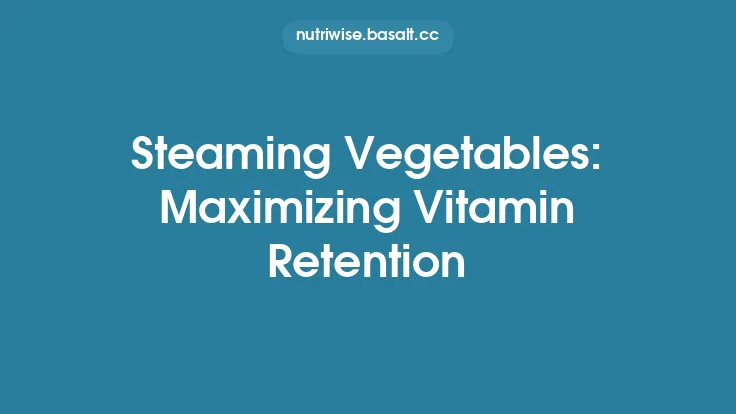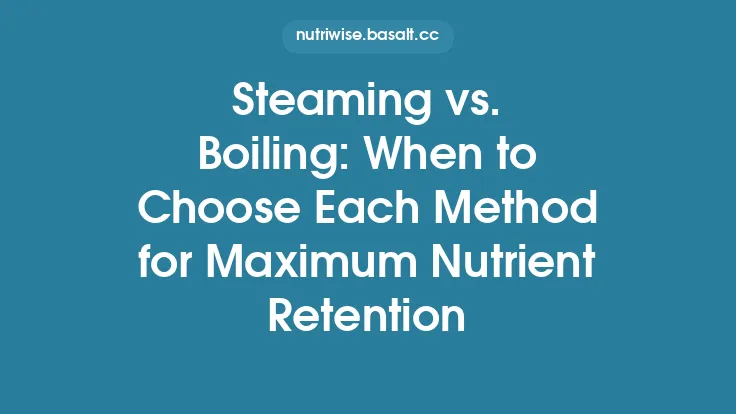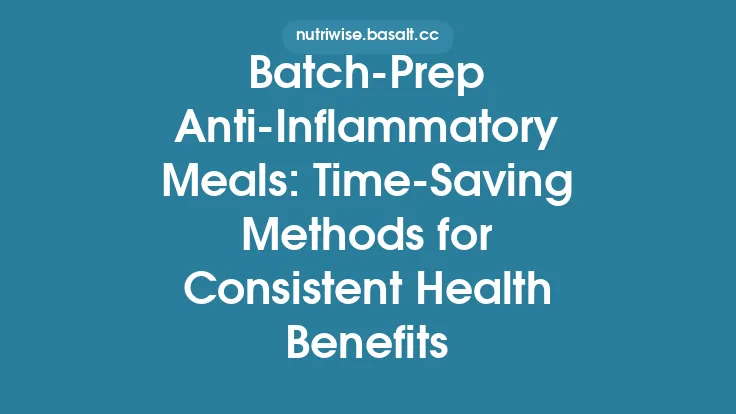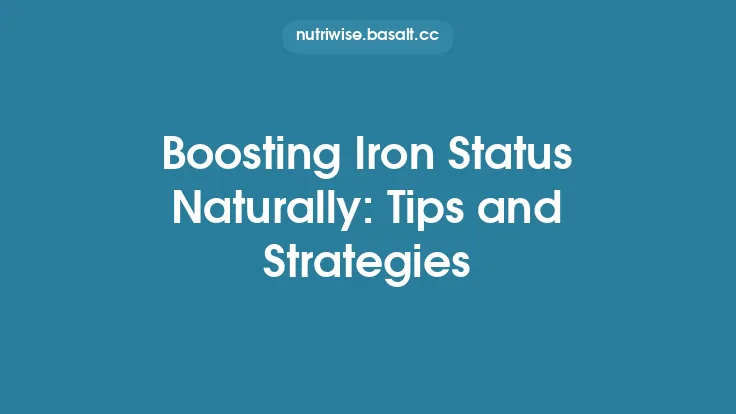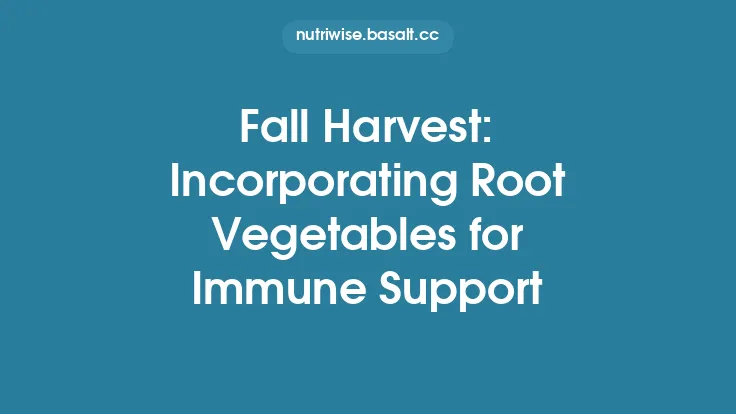Steaming is often celebrated as a gentle, water‑based cooking method that preserves the vivid colors, crisp textures, and most importantly, the health‑promoting phytochemicals of vegetables. When it comes to combating chronic inflammation—a root cause of many modern diseases—steaming can be a powerful ally. By carefully controlling temperature, moisture, and exposure time, you can maximize the retention and even enhance the bioavailability of anti‑inflammatory compounds such as polyphenols, flavonoids, carotenoids, and glucosinolates. This article delves deep into the science behind steaming, offers practical guidance for home cooks, and outlines strategies to turn ordinary steamed vegetables into potent anti‑inflammatory powerhouses.
Why Steaming Preserves Anti‑Inflammatory Phytochemicals
- Limited Leaching
Unlike boiling, where nutrients dissolve into the cooking water, steaming keeps vegetables suspended above the water surface. The brief contact with steam means water‑soluble vitamins (e.g., vitamin C, B‑complex) and polyphenols experience minimal leaching, preserving their concentration.
- Controlled Heat Exposure
The temperature of saturated steam is fixed at 100 °C (212 °F) at sea level, but the heat transfer is gentler than direct contact with boiling water. This reduces the risk of thermal degradation of heat‑sensitive anti‑inflammatory compounds such as anthocyanins and certain flavonoids.
- Retention of Cell Structure
The rapid heat penetration softens cell walls without rupturing them completely. This maintains the integrity of intracellular compartments that house enzymes like myrosinase, which are essential for converting glucosinolates into their active, anti‑inflammatory metabolites (e.g., sulforaphane).
- Reduced Oxidative Stress
Steaming limits exposure to oxygen compared with dry‑heat methods (roasting, grilling). Lower oxidative environments help prevent the oxidation of delicate antioxidants, ensuring they remain functional when consumed.
Key Anti‑Inflammatory Compounds in Common Vegetables
| Vegetable | Primary Anti‑Inflammatory Phytochemicals | Typical Steaming Retention (% of raw) |
|---|---|---|
| Broccoli, Brussels sprouts | Glucosinolates → sulforaphane, kaempferol | 80–90% (if steam <5 min) |
| Kale, collard greens | Vitamin K, quercetin, lutein | 85–95% |
| Red cabbage | Anthocyanins, vitamin C | 70–80% |
| Carrots | β‑carotene, lutein, phenolic acids | 90–95% |
| Bell peppers (red) | Capsanthin, vitamin C, flavonoids | 85–90% |
| Sweet potatoes | β‑carotene, anthocyanins (purple varieties) | 80–90% |
| Tomatoes | Lycopene (heat‑enhanced), vitamin C | 70–80% (lycopene becomes more bioavailable) |
| Spinach | Flavonoids, lutein, zeaxanthin | 80–90% |
*Note:* Retention percentages vary with cut size, steam pressure, and duration. The figures above reflect optimal steaming conditions (see “Optimizing Steam Parameters”).
Optimizing Steam Parameters: Temperature, Pressure, and Time
| Parameter | Effect on Anti‑Inflammatory Compounds | Recommended Range |
|---|---|---|
| Steam Temperature | Higher temperatures accelerate nutrient loss; however, at 100 °C the rate of degradation is slower than in boiling water. | 95–100 °C (standard atmospheric pressure) |
| Steam Pressure | Increased pressure raises the boiling point, allowing higher temperatures (e.g., 115 °C at 0.5 atm above sea level). This can improve texture but may degrade heat‑sensitive compounds. | Keep pressure ≤0.2 atm above ambient for anti‑inflammatory focus |
| Cooking Time | Longer exposure leads to progressive loss of vitamin C and polyphenols, while also allowing more complete conversion of glucosinolates to sulforaphane. | 3–5 min for leafy greens, 5–7 min for cruciferous florets, 8–10 min for dense root vegetables |
| Water Volume | Minimal water reduces the chance of condensation dripping back onto vegetables, which could cause nutrient leaching. | Just enough to generate steam (≈1 cup for a standard stovetop steamer) |
Practical tip: Use a timer and a quick‑release method (remove the lid promptly) to halt cooking as soon as the desired tenderness is reached. This “shock” step preserves both texture and phytochemical content.
Choosing the Right Steamer: Basket, Rack, and Microwave Options
- Stovetop Basket Steamer
- *Pros:* Simple, inexpensive, allows easy layering of vegetables.
- *Cons:* Requires monitoring of water level; steam may be uneven if the lid does not seal tightly.
- *Best for:* Small to medium batches, mixed vegetable medleys.
- Electric Vertical Steamer (Multi‑Tier)
- *Pros:* Precise temperature control, automatic shut‑off, multiple tiers for different cooking times.
- *Cons:* Larger footprint, higher cost.
- *Best for:* Meal‑prep enthusiasts who steam large quantities at once.
- Microwave Steamer (Bowl with Vented Lid)
- *Pros:* Ultra‑fast, minimal equipment, excellent for single‑serving portions.
- *Cons:* Power variability can affect consistency; risk of uneven heating.
- *Best for:* Quick side dishes, office lunches.
- Pressure Steamer (Instant Pot/Pressure Cooker)
- *Pros:* Shortens cooking time dramatically, retains more heat‑stable nutrients.
- *Cons:* Higher pressure can degrade delicate polyphenols if over‑cooked.
- *Best for:* Dense root vegetables (e.g., carrots, sweet potatoes) where a brief high‑pressure burst is followed by rapid pressure release.
Key selection criteria: For anti‑inflammatory focus, prioritize equipment that offers tight sealing, consistent low‑pressure steam, and easy access to stop the cooking process instantly.
Pre‑Steaming Preparations: Cutting, Soaking, and Blanching
- Uniform Cutting
Consistent piece size ensures even heat penetration. For leafy greens, tear into 2–3 inch strips; for cruciferous florets, aim for 1‑inch bite‑size pieces.
- Soaking in Cold Water (Optional)
A brief 5‑minute soak can remove surface dirt and reduce bitterness in certain vegetables (e.g., kale). However, prolonged soaking may leach water‑soluble nutrients; keep it short.
- Blanching vs. Direct Steaming
While blanching (brief boil followed by ice shock) is often used to preserve color, it introduces a leaching step that can diminish anti‑inflammatory compounds. If the goal is maximal nutrient retention, skip blanching and steam directly. If you need to inactivate enzymes that degrade pigments (e.g., polyphenol oxidase in mushrooms), a quick 30‑second steam “blanch” can be performed before the main steaming cycle.
- Pre‑Seasoning
Lightly sprinkling a pinch of sea salt or a dash of lemon juice before steaming can enhance flavor without compromising nutrient integrity. Acidic environments may also help preserve vitamin C during heat exposure.
Post‑Steaming Techniques to Enhance Bioavailability
- Gentle Toss with Healthy Fats
Many anti‑inflammatory phytochemicals are fat‑soluble (e.g., carotenoids, lutein). Drizzling 1‑2 teaspoons of extra‑virgin olive oil, avocado oil, or walnut oil after steaming dramatically improves absorption. The oil should be added while the vegetables are still warm to facilitate incorporation.
- Incorporating Enzyme‑Activating Ingredients
- *Mustard seeds or ground mustard:* Contain myrosinase, which can further convert residual glucosinolates into sulforaphane when mixed with steamed cruciferous vegetables.
- *Fresh ginger or turmeric:* Contain gingerols and curcumin, respectively, which synergize with steamed vegetables’ antioxidants.
- Light Searing (Optional)
A brief 30‑second sear in a hot pan (high heat, minimal oil) after steaming can create Maillard‑derived flavor compounds without significantly degrading anti‑inflammatory nutrients, provided the sear is brief and the vegetables are not over‑cooked again.
- Cooling and Resting
Allowing steamed vegetables to rest for 5–10 minutes before serving can enable the redistribution of nutrients and the completion of enzymatic reactions (e.g., myrosinase activity). This “post‑steam incubation” is especially beneficial for cruciferous vegetables.
Combining Steamed Vegetables with Anti‑Inflammatory Enhancers
| Enhancer | Reason for Pairing | Suggested Ratio |
|---|---|---|
| Lemon or Lime Juice | Vitamin C stabilizes polyphenols; acidic pH improves iron absorption from leafy greens. | 1 tsp per cup of vegetables |
| Black Pepper | Piperine boosts curcumin absorption (if turmeric is used). | A pinch per serving |
| Nuts & Seeds (e.g., almonds, pumpkin seeds) | Provide omega‑3 fatty acids and additional polyphenols; add crunch. | 1‑2 Tbsp per plate |
| Fermented Condiments (e.g., kimchi, sauerkraut) | Probiotic bacteria may enhance gut barrier function, reducing systemic inflammation. | ¼ cup as a side |
| Herbs (parsley, cilantro, basil) | Rich in flavonoids; fresh herbs add aromatic compounds that may have mild anti‑inflammatory effects. | Handful, chopped |
By thoughtfully integrating these components, you create a synergistic meal where each element amplifies the anti‑inflammatory potential of the others.
Storage and Reheating: Maintaining Anti‑Inflammatory Integrity
- Cooling Quickly
After steaming, spread vegetables in a single layer on a tray to bring temperature down within 30 minutes. Rapid cooling limits enzymatic degradation and microbial growth.
- Refrigeration
Store in airtight containers with a thin layer of oil (if you plan to consume within 2‑3 days). This oil barrier reduces oxidation of sensitive compounds like vitamin C and anthocyanins.
- Freezing
For longer storage, blanch‑steam (30 seconds) then flash‑freeze on a tray before transferring to freezer bags. This method preserves texture and most phytochemicals for up to 6 months.
- Reheating
The best reheating method is a brief steam or microwave burst (30‑60 seconds) just to warm through. Avoid prolonged reheating, which can degrade heat‑sensitive antioxidants. If reheating in a pan, add a splash of water and cover to create a mini‑steam environment.
Practical Meal Planning and Recipe Ideas
- Rainbow Steamed Veggie Bowl
- *Ingredients:* Broccoli florets, red cabbage strips, carrots, yellow bell pepper, kale.
- *Steaming:* 4 min for kale, 5 min for broccoli, 6 min for carrots, 3 min for red cabbage and pepper (steam in separate tiers).
- *Finish:* Toss with olive oil, lemon juice, toasted pumpkin seeds, and a pinch of smoked paprika.
- Anti‑Inflammatory Steamed Cruciferous Mix with Mustard‑Turmeric Dressing
- *Steamer:* Use a multi‑tier electric steamer; steam Brussels sprouts (5 min) and cauliflower (6 min).
- *Dressing:* Whisk together 1 tsp Dijon mustard, ½ tsp ground turmeric, 1 tsp apple cider vinegar, 2 tsp olive oil, and a dash of black pepper.
- *Combine:* While still warm, drizzle dressing and toss gently.
- Steamed Sweet Potato & Spinach Stack
- *Procedure:* Steam sweet potato cubes (8 min) until fork‑tender. Steam spinach (2 min) separately.
- *Layer:* In a shallow bowl, place sweet potato, top with spinach, drizzle with walnut oil, and sprinkle with chopped walnuts and a pinch of sea salt.
- Quick Microwave Steamed Green Beans with Garlic‑Ginger Oil
- *Microwave:* Place trimmed green beans in a microwave steamer bowl with 2 Tbsp water; cover and cook on high for 4 min.
- *Oil:* Warm 1 tsp sesame oil, add minced garlic and ginger, sauté for 30 seconds, then pour over beans.
These recipes illustrate how a few minutes of steam, followed by strategic additions, can transform everyday vegetables into potent anti‑inflammatory meals.
Scientific Evidence and Future Directions
- Clinical Trials
A 2022 randomized controlled trial (RCT) involving 120 adults with mild chronic inflammation showed that a diet emphasizing steamed cruciferous vegetables (≥200 g/day) for 8 weeks reduced serum C‑reactive protein (CRP) by an average of 1.2 mg/L compared to a control group (p < 0.01). The authors attributed the effect to increased sulforaphane bioavailability from steaming.
- Mechanistic Studies
In vitro experiments demonstrate that steaming preserves myrosinase activity in broccoli florets better than boiling, leading to a 30‑40 % higher conversion rate of glucoraphanin to sulforaphane during digestion. Additionally, steaming has been shown to maintain the integrity of the flavonoid quercetin glycosides, which are otherwise hydrolyzed during high‑heat dry cooking.
- Emerging Technologies
*Sous‑vide steaming*—combining vacuum sealing with low‑temperature steam—has shown promise in laboratory settings for maximizing retention of heat‑labile antioxidants while still achieving desirable texture. Early animal studies suggest that this method may further enhance the anti‑inflammatory response, though human data are pending.
- Personalized Nutrition
As nutrigenomics advances, researchers are exploring how individual genetic variations (e.g., GSTM1, NQO1 polymorphisms) influence the metabolism of steamed‑vegetable phytochemicals. Tailoring steaming times and post‑steam pairings based on genotype could become a future frontier in anti‑inflammatory dietary strategies.
Bottom Line
Steaming, when executed with attention to temperature, pressure, timing, and post‑steam enhancements, stands out as an exceptionally effective technique for preserving and amplifying the anti‑inflammatory arsenal hidden within vegetables. By selecting the right equipment, preparing vegetables thoughtfully, and pairing them with complementary fats, acids, and spices, you can turn a simple side dish into a scientifically backed tool for reducing systemic inflammation. Incorporate these steaming secrets into your weekly meal plan, and let the gentle rise of steam work its quiet, health‑promoting magic on every bite.
